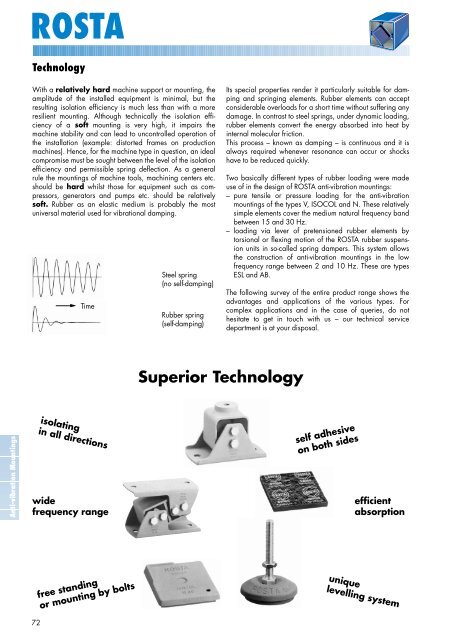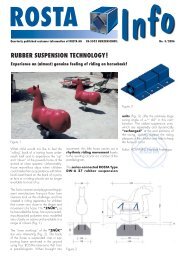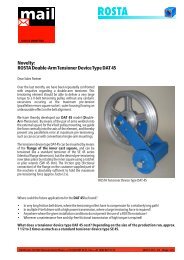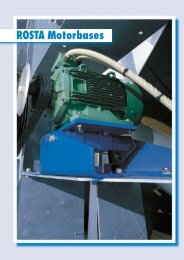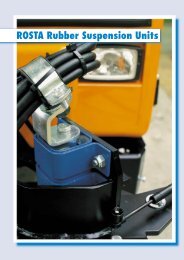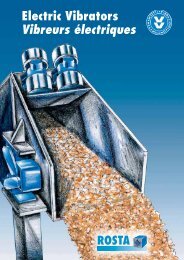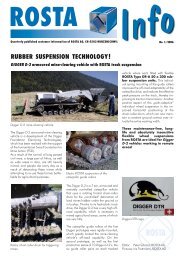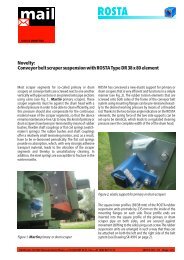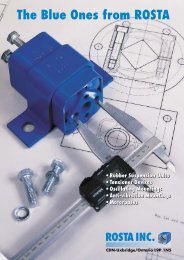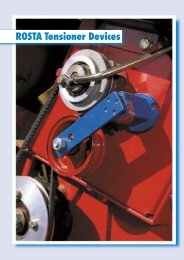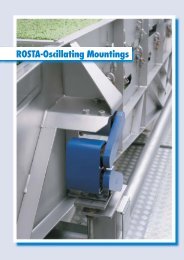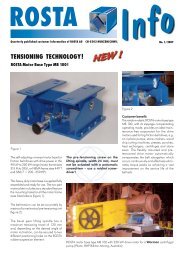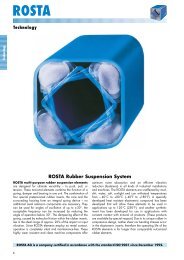ROSTA Anti-vibration Mountings - ROSTA Inc.
ROSTA Anti-vibration Mountings - ROSTA Inc.
ROSTA Anti-vibration Mountings - ROSTA Inc.
You also want an ePaper? Increase the reach of your titles
YUMPU automatically turns print PDFs into web optimized ePapers that Google loves.
<strong>ROSTA</strong><br />
Technology<br />
With a relatively hard machine support or mounting, the<br />
amplitude of the installed equipment is minimal, but the<br />
resulting isolation efficiency is much less than with a more<br />
resilient mounting. Although technically the isolation efficiency<br />
of a soft mounting is very high, it impairs the<br />
machine stability and can lead to uncontrolled operation of<br />
the installation (example: distorted frames on production<br />
machines). Hence, for the machine type in question, an ideal<br />
compromise must be sought between the level of the isolation<br />
efficiency and permissible spring deflection. As a general<br />
rule the mountings of machine tools, machining centers etc.<br />
should be hard whilst those for equipment such as compressors,<br />
generators and pumps etc. should be relatively<br />
soft. Rubber as an elastic medium is probably the most<br />
universal material used for <strong>vibration</strong>al damping.<br />
Time<br />
Steel spring<br />
(no self-damping)<br />
Rubber spring<br />
(self-damping)<br />
Its special properties render it particularly suitable for damping<br />
and springing elements. Rubber elements can accept<br />
considerable overloads for a short time without suffering any<br />
damage. In contrast to steel springs, under dynamic loading,<br />
rubber elements convert the energy absorbed into heat by<br />
internal molecular friction.<br />
This process – known as damping – is continuous and it is<br />
always required whenever resonance can occur or shocks<br />
have to be reduced quickly.<br />
Two basically different types of rubber loading were made<br />
use of in the design of <strong>ROSTA</strong> anti-<strong>vibration</strong> mountings:<br />
– pure tensile or pressure loading for the anti-<strong>vibration</strong><br />
mountings of the types V, ISOCOL and N. These relatively<br />
simple elements cover the medium natural frequency band<br />
between 15 and 30 Hz.<br />
– loading via lever of pretensioned rubber elements by<br />
torsional or flexing motion of the <strong>ROSTA</strong> rubber suspension<br />
units in so-called spring dampers. This system allows<br />
the construction of anti-<strong>vibration</strong> mountings in the low<br />
frequency range between 2 and 10 Hz. These are types<br />
ESL and AB.<br />
The following survey of the entire product range shows the<br />
advantages and applications of the various types. For<br />
complex applications and in the case of queries, do not<br />
hesitate to get in touch with us – our technical service<br />
department is at your disposal.<br />
Superior Technology<br />
<strong>Anti</strong>-<strong>vibration</strong> <strong>Mountings</strong><br />
isolating<br />
in all directions<br />
wide<br />
frequency range<br />
self adhesive<br />
on both sides<br />
efficient<br />
absorption<br />
free standing<br />
or mounting by bolts<br />
unique<br />
levelling system<br />
72


